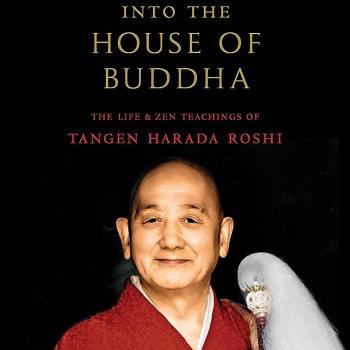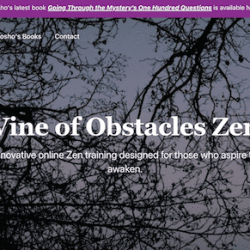
Above is a “sleeping stick,” apparently used by monks in China and then for a while in Japan to prop themselves up during late night sitting. Some monks renounced the comfort of the nest by vowing not to sleep lying down for long periods, like for the rest of their lives. I knew a guy in the 80’s who had studied at the City of Ten Thousand Buddhas who made that vow. He slept leaning against a wall, although aimed to eventually be able to maintain the zazen pose and sleep. I wonder how that’s going for him.
Anyway, sleeping sticks are now mostly used as Zen nick-knacks. The above stick has calligraphy by one of the great Soto masters of the 20th Century, Kojun Noiri Roshi (click for an interesting interview with Noiri Roshi about Suzuki Roshi), one of Katagiri Roshi’s teachers. Katagiri Roshi had a sleeping stick like the one pictured, about four inches wide and about two feet long. The top part of his was bevelled for the chin. Supposedly, the sleeping stick would be placed under the chin and then through the folded legs onto the tatami, propping up (or maybe waking up) the drooping sitter.
I tried to use Roshi’s just out of curiosity but it was way too short to reach the floor so I put it on my upturned heel. Having a fairly narrow surface to support my big head by the chinny-chin was torture. I couldn’t imagine being able to sleep with one of these.
The purpose of this wandering introduction has been to give some background for the sleeping-stick reference by Dogen in the following Dharma Hall Discourse, #348.
The sitting cushions of the seven Buddhas
are now about to be worn through;
The sleeping stick of my [old] teacher has been transmitted.
Eyes and nose should be upright and straight,
headtop reaching up to the blue sky,
and ears aligned above the shoulders.
At this very time, how is it?
After a pause Dogen said:
Do not control the monkey mind
or the horse will.
Make effort like a lotus in fire.
The middle part is very straightforward zazen instruction cuddled between a pointer and a capper. The seven Buddhas are the primordial Buddhas, teachers of Shakyamuni. Dogen seems to be saying that the instruction that follows is the culmination of long practice so that the zafu is nearly worn through – or broken. After a long search, the sleeping stick has been handed on. The sleeping stick is a prop for those who are asleep or at least trying to sleep. The zazen pose is presented, then, as both the near-full accomplishment of the seven Buddhas and as an artifice for the deluded.
How do you see it?
As for the capper about monkeys, horses, and fire: Zazen is not about control. Just bloom, says Dogen, in and inseparably from the burning conditions of this fleeting life.











